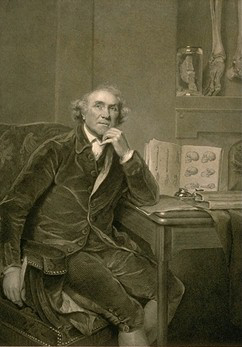1902 Encyclopedia > Medicine > English Medicine from 1800 to 1840
Medicine
(Part 37)
English Medicine from 1800 to 1840
The progress of medicine in England during this period displays the name characteristics as at other times, viz., a gradual and uninterrupted development, without startling changes such as are caused by the sudden rise or fall of a new school. Hardly any theoretical system is of English birth; Erasmus Darwin (1731-1802), the grandfather of the great Charles Darwin, alone makes an exception. In his Zoonomia (1794) he expounded a theory of life and disease which had some resemblance to that of Brown, though arrived at (he says) by a different chain of reasoning.

John Hunter (1728-93),
famous Scottish surgeon, pathologist and comparative anatomist
Darwin’s work shows, however, the tendency to connect medicine with physical science which was a immediate consequence of the scientific discoveries of the end of the 18th century, when Priestley and Cavendish in England exercised the same influence as Lavoisier in France. The English school of medicine was also profoundly stirred by the teachings of the two brothers William and John Hunter, especially the latter, -- who must therefore be briefly mentioned, though their own researches were chiefly concerned with subjects lying a little outside the limits of this sketch. William Hunter (1718-1783) was known in London as a brilliant teacher of anatomy and successful obstetric physician; his younger brother and pupil, John Hunter (1728-1793), was also a teacher of anatomy, and practised as a surgeon. His immense contributions to anatomy and pathology cannot be estimated here, but his services in stimulating research and training investigators belong to the history of general medicine. They are sufficiently evidenced by the fact that Jenner and Baillie were his pupils.
The same scientific bent is seen in the greater attention paid to morbid anatomy (which dated from Baillie), and the more scientific method of studying diseases. An instance of the latter is the work of Robert Willan (1757-1812) on diseases of the skin, -- a department of medicine in which abstract and hypothetical views had been especially injurious. Willan, by following the natural-history method of Sydenham, at once put the study on a sound basis; and his work has been the starting point of the most important modern researches. About the same time William Charles Wells (1757-18170, a scientific investigator of remarkable power, and the author of a celebrated essay on dew, published observations on alterations in the urine, which, though little noticed at the time, were of great value as assisting in the important discovery made some years afterwards by Bright.
These observers, and others who cannot be mentioned here, belong to the period when English medicine was still little influenced by the French school. Shortly after 1815, however, when the Continent was again open to English travelers, many English doctors studied in Paris, and the discoveries of their great French contemporaries began to be known. The method of auscultation was soon introduced into this country by pupils of Laennec. John Forbes in 1824, and William Stokes of Dublin in 1825, published treatises on the use of the stethoscope. Forbes and entire revolution was soon affected in the knowledge of diseases of the chest. James Hope and Peter Mere Latham further developed this subject, and the former was also known for his researches in morbid anatomy. The combination of clinical and anatomical research led, as in the hands of the great French physicians, to important discoveries by English investigators. The discovery by Richard Bright (1789-1858) of the diseases of the kidneys known by his name, has proved to be one of the most momentous of this century. It was published in Reports of Medical Cases, 1827-31. Thomas Addison takes, somewhat later, a scarcely inferior place. The remarkable physiological discoveries of Bell and Marschall Hall for the first time rendered possible the discrimination of diseases of the spinal cord. Several of these physicians were also eminent for their clinical teaching, -- an art in which Englishmen had up till then been greatly deficient.
Although may names of scarcely less note might be mentioned among the London physicians of the early part of the century, we must pass them over to consider the progress of medicine in Scotland and Ireland. In Edinburgh the admirable teaching of Cullen had raised the medical faculty to a height of prosperity of which his successors, James Gregory (1758-1821), was not unworthy. His nephew, William Pulteney Alison (1790-1859), was even more widely known. These great teachers maintained in the northern university a continuous tradition of successful teaching, which the difference in academical and other circumstances rendered hardly possible in London. Nor was the northern school wanting in special investigators, such as John Abercrombie, known for his work on diseases of the brain and spinal cord published in 1828, and many others. Turning to Ireland, it should be said that, the Dublin school in this period produced two physicians of the highest distinction. Robert James Graves (c. 1800-1853) was a most eminent clinical teacher and observer, whose lectures are regarded as the model of clinical teaching, and indeed served as such to the most popular teacher of the Paris school in the middle of this century, Trousseau. William Strokes (1804-1878) was especially known for his works on diseases of the chest and of the heart, and for his clinical teaching.
Read the rest of this article:
Medicine - Table of Contents
|
